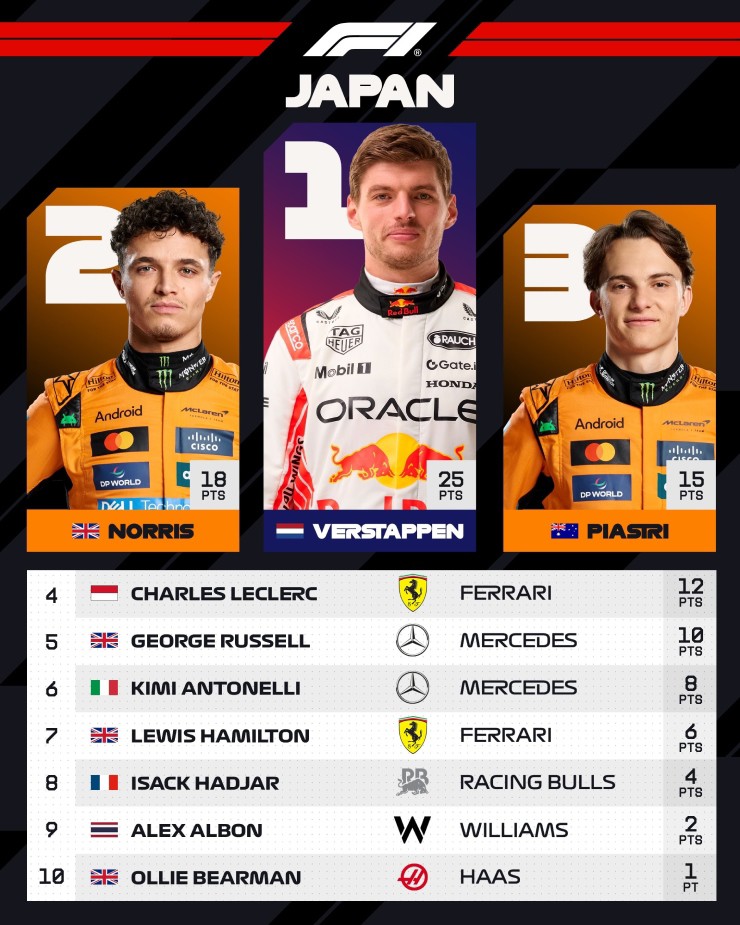The recent Japanese Grand Prix marked the beginning of a triple-header weekend in Formula 1, a challenging period for drivers and teams alike. With minimal rest between races, the stakes are high, and the pressure mounts as teams navigate the complexities of performance, strategy, and team dynamics. This year’s race brought a mix of excitement and disappointment, with significant developments both on and off the track.
Race Recap: A Mixed Bag
The Japanese Grand Prix is known for its unpredictable weather and varying track conditions, which can influence the quality of the race. Historically, the 2022 race was memorable despite being only 15 laps long due to rain, while the 2023 race fell flat when dry conditions led to a lackluster performance. In 2024, expectations were high for a more engaging event, particularly with the competitive nature of the current grid.

The performance chart suggested a tighter race, especially with McLaren showing promise. However, the race itself was relatively uneventful, with few standout moments. Max Verstappen, driving for Red Bull, managed to secure pole position, but the race lacked significant drama—until the pit stops, that is. Verstappen and Lando Norris pitted simultaneously, leading to a brief moment of excitement when Norris attempted an overtake that ended in disaster.
Ultimately, Verstappen held on to win, with both McLarens finishing on the podium. The victory, although hard-fought, left fans wanting more in terms of action.
Major Developments: Driver Swaps and Team Turmoil
Before the race, two significant events rocked the paddock: the Yuki Tsunoda and Liam Lawson driver swap and indications of internal strife at Red Bull. The decision to replace Lawson with Tsunoda, especially after only two race weekends, raised eyebrows and showcased the team’s ongoing struggles.
Verstappen’s reaction to the swap was particularly revealing. His support for Lawson on social media suggested dissatisfaction with the team’s decision-making, which could indicate cracks in the once-unshakeable confidence that characterized Red Bull during their dominant years. When asked about his faith in the team, Verstappen’s vague responses hinted at uncertainty, a stark contrast to his usual optimism.
Winners of the Weekend
Among the winners, Max Verstappen stood out not only for his victory but also for his ability to extract performance from a car that many believe is faltering. Despite the challenges, Verstappen’s skill shone through, showcasing his resilience as a driver. The win reinforced his position in the championship race, though the overall performance of Red Bull continues to raise questions.
McLaren also emerged as a winner, demonstrating their pace and consistency. Both Norris and his teammate showcased impressive speed, solidifying McLaren’s status as a formidable competitor this season. Their ability to consistently challenge for podiums has rejuvenated the team’s image and performance.
Olli Behrman, a rookie driver, made waves by performing well in qualifying and the race, proving that he could be a valuable asset for his team moving forward. His impressive results hinted at a bright future in F1.

Losers of the Weekend
On the flip side, Red Bull, excluding Verstappen and Tsunoda, found themselves on the loser’s list. The team’s struggles with car performance were evident, and the ongoing issues with reliability and pace put them at a disadvantage compared to their competitors. The fact that their second team, Toro Rosso, outperformed them only added insult to injury.
Jack Doohan also faced a tough weekend, marked by a crash that raised concerns about his consistency and decision-making. As a driver still finding his footing in F1, he will need to address these issues quickly to remain competitive.
Esteban Ocon struggled against his teammate, with his performance falling short of expectations. As his teammate thrived, Ocon’s inability to capitalize on opportunities painted a concerning picture for his future in the sport.
The Pirelli Dilemma
An additional point of contention was the performance of Pirelli tires. Many fans and commentators criticized the fact that some tires wore out too quickly while others lasted far too long, leading to a lack of excitement during the race. This inconsistency is often blamed for the overall dullness of recent races and has sparked discussions about the need for better tire management in the sport.
Conclusion: Looking Ahead
As the F1 calendar moves to the next race in Bahrain, the Japanese Grand Prix serves as a reminder of the unpredictable nature of motorsport. The challenges faced by teams and drivers highlight the importance of adaptability and resilience in the face of adversity.
With the upcoming triple-header, the pressure will intensify as teams continue to vie for points and positioning in the championship. For Kvyat and others, the path back to success in F1 remains uncertain, but the drama and excitement of the sport will undoubtedly continue to unfold in the coming weeks.
As always, fans are eager to see how these developments will impact the championship landscape, and discussions about winners and losers will persist long after the checkered flag has waved.